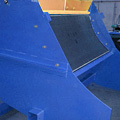DUST CONTROL PRACTICES
December 8, 2014
An ore extraction operation is gauged on the speed of a conveyor system, how efficient a screening solution functions, and too many other factors to count. Management’s job is to keep the operation running with a focus on this need for productivity but at what cost? As worthy a task as this is, it can’t come at the cost of the human factor, because every mining operation has a responsibility to account for the occupational hazards that occur away from the smoothly flowing mass of ore and crushed rock. Let’s shift our scope of attention away from the machinery, it’s well looked after, and provide for the human side of the mining equation.
What exactly are the dangers faced by our miners and quarry workers? An employee working within each of these disciplines is engaged upon hard manual labour, work that comes with known risks. Underground tunnels are bolstered to prevent collapses, and safety regulations account for contact between the soft tissue of an operator and heavy machinery, but dust is a an element that’s harder to manage, especially in the confines of a mine. And make no mistake, the constant screening and crushing of rock will produce large volumes of dust.
Part of the solution comes from the provision of special gear, masks and eye protection that’s certified to offer high levels of protection, but the rest of the answer can be found in dust monitoring practices.
Health-compromising dust and airborne particles include
- Coal dust
- Airborne silica (Fine quartz)
- Heavy metals such as arsenic and lead
HOW TO REDUCE EXPOSURE THROUGH ENGINEERING PRACTICES
Staying within the outlined guidelines of the Australian AS3640 standard means avoiding the lung scarring threat of pneumoconiosis, including silicosis and the colourfully titled black lung disorder, by instituting potent dust cessation mechanisms. A wetting agent instantly cuts the presence of airborne threats. An exhaust system obviously allows contaminants to leave areas where airflow is poor, but include individual exhausts with dust collecting solutions to maximize this approach.
Occupational dust control is a tough problem in the remote desert areas where many mines are located. As any engineer knows, only pure water will work as a wetting agent, and this is a scarce resource in the outback, for brine water will chemically react with the ore. Further investigation suggests water harvesting and recycling will offset this dry obstacle.
Screening Technology Pty Ltd T/AS Hawk Machinery
Address: 7 Lantana St Blackburn North Vic 3130
Contact Person: Bohdan Blaszczyk
Phone: +61 3 9877 7777
Fax: +61 3 9877 8177
Mobile: 0411 099 989
Email: info@hawkmachinery.com.au
Optimized by NetwizardSEO.com.au
Optimized by: Netwizard SEO


